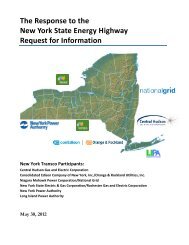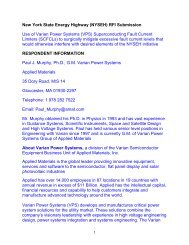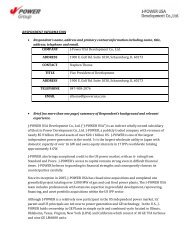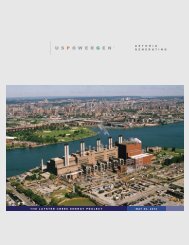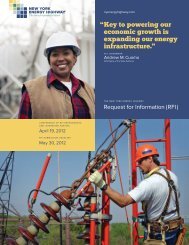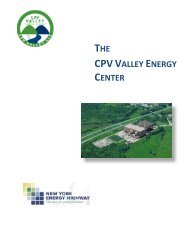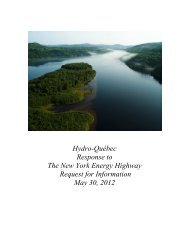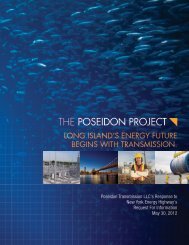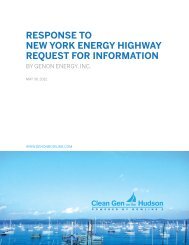Beacon Power, LLC Response to the New York Energy Highway ...
Beacon Power, LLC Response to the New York Energy Highway ...
Beacon Power, LLC Response to the New York Energy Highway ...
You also want an ePaper? Increase the reach of your titles
YUMPU automatically turns print PDFs into web optimized ePapers that Google loves.
frequent and unpredictable wind and solar ramping events and hence can reduce <strong>the</strong> overall<br />
expense of regulation reserves required <strong>to</strong> integrate wind.<br />
Flywheel energy s<strong>to</strong>rage technologies can provide Regulation Service a la carte. This<br />
reduces <strong>the</strong> need <strong>to</strong> run additional generation units at night in order compensate for overgeneration<br />
by wind resources. When <strong>the</strong> wind blows during off-peak hours, few genera<strong>to</strong>rs will<br />
be on-line <strong>to</strong> provide Regulation Service. Those genera<strong>to</strong>rs that are operating are likely <strong>to</strong> be<br />
running at or near <strong>the</strong>ir minimum operating level, meaning that <strong>the</strong>y would be unavailable <strong>to</strong><br />
provide Regulation Down service. This over–generation situation is fur<strong>the</strong>r exacerbated by<br />
needing <strong>to</strong> ei<strong>the</strong>r move <strong>the</strong>se units above <strong>the</strong>ir minimum operating level or bringing additional<br />
units on-line for Regulation service if those operating are not Regulation-capable. Conversely,<br />
advanced energy s<strong>to</strong>rage can provide Regulation a la carte. With <strong>Beacon</strong> <strong>Power</strong>’s flywheel<br />
energy s<strong>to</strong>rage on <strong>the</strong> system, opera<strong>to</strong>rs will not need <strong>to</strong> ramp up genera<strong>to</strong>rs operating in offpeak<br />
hours, or bring on additional generation <strong>to</strong> provide Regulation Service.<br />
Flywheel energy s<strong>to</strong>rage produces fewer emissions when providing Regulation than<br />
conventional generation. Unlike genera<strong>to</strong>rs that consume fossil fuel, <strong>Beacon</strong> <strong>Power</strong>’s flywheel<br />
technology recycles existing power, <strong>the</strong>reby lowering its operating costs <strong>to</strong> provide regulation<br />
and benefiting <strong>the</strong> environment by producing zero direct CO2 greenhouse gas, particulates or<br />
o<strong>the</strong>r air emissions. 5 A study by KEMA concluded that a 20 MW Flywheel <strong>Energy</strong> S<strong>to</strong>rage<br />
System emits 56% less CO2 than a natural gas power plant providing regulation and 26% less<br />
emissions than a pumped hydro power plant. 6 KEMA notes that continued reliance on <strong>the</strong>rmal<br />
generating units <strong>to</strong> meet increased regulation requirements could actually increase emissions<br />
of CO2, NOX and o<strong>the</strong>r pollutants, <strong>the</strong>reby defeating one of <strong>the</strong> main benefits of wind<br />
generation. 7<br />
3.<br />
Maximizes <strong>New</strong> <strong>York</strong> state ratepayer value in <strong>the</strong> operation of power grid.<br />
As discussed above, by providing a significantly greater amount of frequency regulation<br />
service per MW of capacity, flywheel energy s<strong>to</strong>rage can provide a cost-effective solution for<br />
maintaining system reliability thus maximizing ratepayer value. In addition, flywheel energy<br />
s<strong>to</strong>rage has <strong>the</strong> potential <strong>to</strong> reduce Regulation costs for ratepayers by introducing new<br />
competition <strong>to</strong> NYISO’s regulation market and displacing high cost conventional generation.<br />
<strong>Beacon</strong> <strong>Power</strong>’s flywheel technology is a lower cost alternative than conventional<br />
generation for regulation. <strong>Beacon</strong> <strong>Power</strong> has a fundamental operating cost advantage because<br />
5 Some emissions from flywheels occur indirectly, because some electricity from <strong>the</strong> grid must be used <strong>to</strong><br />
compensate for energy losses during operation.<br />
6 KEMA, Emissions Comparison for a 20MW Flywheel-based Frequency Regulation <strong>Power</strong> Plant, May 18, 2007.<br />
7 Id.<br />
5



